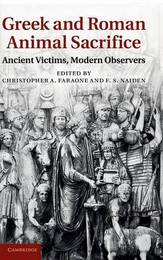
|
Greek and Roman Animal Sacrifice: Ancient Victims, Modern Observers
Hardback
Main Details
| Title |
Greek and Roman Animal Sacrifice: Ancient Victims, Modern Observers
|
| Authors and Contributors |
Edited by Christopher A. Faraone
|
|
Edited by F. S. Naiden
|
| Physical Properties |
| Format:Hardback | | Pages:224 | | Dimensions(mm): Height 229,Width 155 |
|
| Category/Genre | Ancient religions and mythologies
Worship, rites and ceremonies |
|---|
| ISBN/Barcode |
9781107011120
|
| Classifications | Dewey:292.34 |
|---|
| Audience | | Professional & Vocational | |
|---|
| Illustrations |
1 Tables, black and white; 31 Halftones, black and white; 1 Line drawings, black and white
|
|
Publishing Details |
| Publisher |
Cambridge University Press
|
| Imprint |
Cambridge University Press
|
| Publication Date |
22 March 2012 |
| Publication Country |
United Kingdom
|
Description
The interpretation of animal sacrifice, now considered the most important ancient Greek and Roman religious ritual, has long been dominated by the views of Walter Burkert, the late J.-P. Vernant, and Marcel Detienne. No penetrating and general critique of their views has appeared and, in particular, no critique of the application of these views to Roman religion. Nor has any critique dealt with the use of literary and visual sources by these writers. This book, a collection of essays by leading scholars, incorporates all these subjects and provides a theoretical background for the study of animal sacrifice in an ancient context.
Author Biography
Christopher A. Faraone is the Frank Curtis Springer and Gertrude Melcher Springer Professor in the Humanities at the University of Chicago. F. S. Naiden is Associate Professor of History at the University of North Carolina, Chapel Hill.
Reviews'This is an interesting and thought-provoking book that encourages us always to be aware of the limits of our evidence and to ask where our ideas have come from. It renders a service to scholarship in doing so.' Bryn Mawr Classical Review 'F. S. Naiden's essay takes up the question of sacrificial commensality, and poses obvious practical questions: how much meat did an animal yield? How many people ate? How much did they get? He doesn't give definite answers to any of these questions, but employs a fascinating range of evidence ... making use of the latest studies, Greek and Roman Animal Sacrifice provides a fine introduction to the state of the question.' Christopher S. Faraone, First Things
|